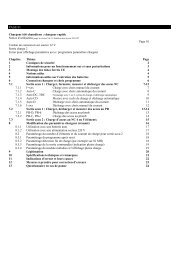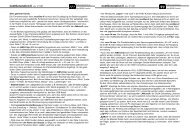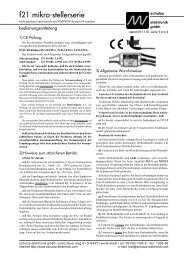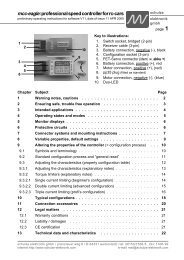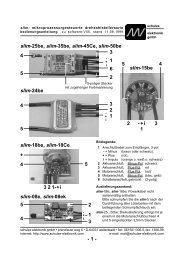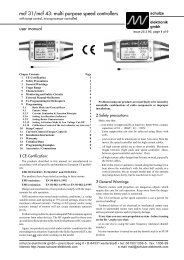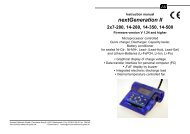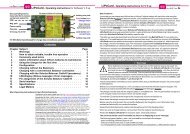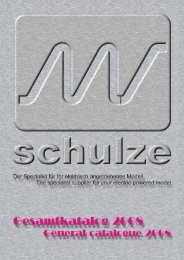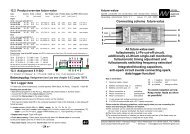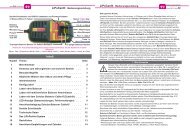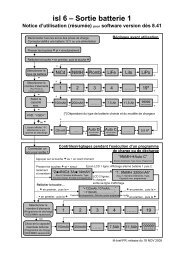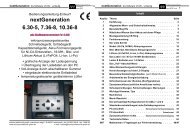ecolader: rapid discharger/charger series - Schulze Elektronik GmbH
ecolader: rapid discharger/charger series - Schulze Elektronik GmbH
ecolader: rapid discharger/charger series - Schulze Elektronik GmbH
You also want an ePaper? Increase the reach of your titles
YUMPU automatically turns print PDFs into web optimized ePapers that Google loves.
<strong>ecolader</strong>: <strong>rapid</strong> <strong>dis<strong>charger</strong></strong>/<strong>charger</strong> <strong>series</strong><br />
Operating instructions for software V1.04, date of issue 05 MAY 1998<br />
5 Useful information about<br />
battery care<br />
5.1 General information:<br />
A cold cell cannot absorb so much current as a<br />
warm one, and for this reason you can expect<br />
seasonal differences in charge behaviour<br />
if you use the fully automatic charge<br />
current calculation. In Winter your packs will<br />
not accept as much charge as in Summer.<br />
The lower the internal resistance of the battery,<br />
the higher the <strong>charger</strong> can push the charge<br />
rate. Note that a <strong>charger</strong> which calculates<br />
the charge rate automatically also takes<br />
into account the resistance of the charge<br />
cables. So: use short cables of large<br />
conductor cross-section (even for receiver<br />
battery cables). Do not charge via a<br />
switch or switch harness!<br />
5.2 Nickel-Cadmium batteries:<br />
Selecting the charge current (manual selection):<br />
Charge current = 2 x C (C = nominal battery<br />
capacity)<br />
If a pack is not regularly maintained, or is<br />
brand-new, it can often take several discharge/charge<br />
cycles for it to reach a completely<br />
balanced condition.<br />
As a general rule you can calculate a suitable<br />
discharge current for an accurate measurement<br />
of battery capacity as follows:<br />
Discharge current = 1/10 C (C = nominal<br />
battery capacity)<br />
In practice however, higher discharge currents<br />
can be tolerated, depending on the<br />
degree of accuracy you require.<br />
Our automatic method of calculating charge<br />
current is the subject of a patent application,<br />
and provides optimum protection to your Ni-<br />
Cd packs against damage. The reduced<br />
charge current towards the end of the process<br />
ensures maximum energy absorption<br />
and minimal temperature rise, as can easily<br />
be ascertained in comparison with conventional<br />
constant current charging procedures.<br />
schulze<br />
elektronik<br />
gmbh<br />
Page 5<br />
Note that the lower charge current which is applied<br />
with 1-5 cells, combined with the small<br />
voltage "kink" with high-capacity packs, may<br />
lead to difficulties in detecting the Peak<br />
when such packs are <strong>rapid</strong>-charged.<br />
To erase the memory effect it is common practice<br />
amongst model car operators to discharge<br />
each cell (individually!) via resistor of<br />
about 68 Ohm.<br />
This process deliberately "unbalances" the<br />
pack.<br />
However, this procedure may result in the<br />
<strong>charger</strong> terminating the process prematurely<br />
of the subsequent charge.<br />
Storage: Ni-Cd batteries must therefore be discharged<br />
down to the final discharge voltage<br />
after use, in order to prevent the occurrence<br />
of the memory effect, and to maintain the<br />
pack's full capacity.<br />
5.3 Lead-acid batteries:<br />
Lead-acid batteries cannot be charged using<br />
the <strong>ecolader</strong>. However, in the interests of<br />
completeness we are providing a little background<br />
information on the subject.<br />
The characteristics of lead-acid batteries are<br />
entirely different from those of Ni-Cd sintered-cell<br />
packs, which are used as the<br />
power source in model aircraft, model cars<br />
and hydroplane boats. Lead-acid batteries<br />
can only be discharged at relatively low currents<br />
if their full capacity is to be exploited,<br />
and/or their voltage is not to collapse too<br />
far.<br />
As with discharging, these batteries may only<br />
be charged at low currents (0.1 C, voltagelimited).<br />
The charge period is then in the order<br />
of 20 hours.<br />
The nominal capacity (i.e. charge duration) can<br />
be reduced very quickly by incorrect maintenance<br />
(overcharging, many 100% discharges<br />
and especially deep discharges). Read<br />
the instructions supplied with your batteries.<br />
Storage: if lead-acid batteries are to be maintained<br />
at full capacity, they must be stored<br />
in the charged state, in contrast to Ni-Cd<br />
packs.<br />
schulze elektronik gmbh • prenzlauer weg 6 • D-64331 weiterstadt • tel: 06150/1306-5, fax: 1306-99<br />
internet: http://www.schulze-elektronik.com e-mail: mail@schulze-elektronik.com



